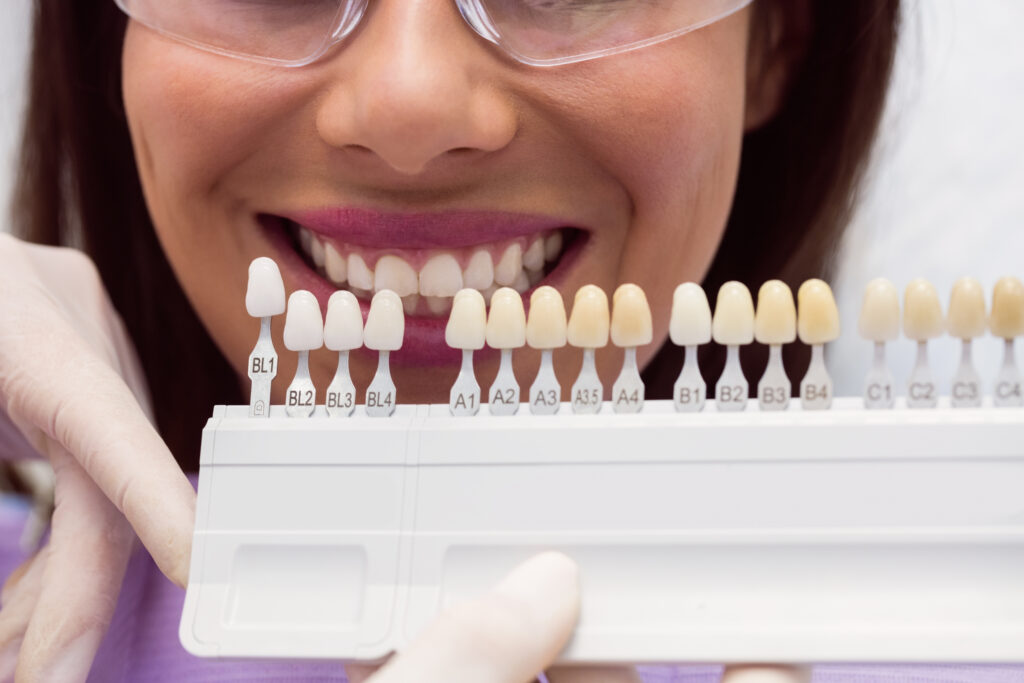How to Pick the Best Shade for Veneers and Crowns

A million-dollar smile – this phrase didn’t come into existence without reason. And these beautiful smiles often exist because of perfectly aligned and symmetrical teeth. Well-proportioned teeth not only boost your confidence and leave lasting impressions, but they are also vital for basic procedures such as chewing and ensuring a healthy, bacteria-free mouth. Various cosmetic dental procedures can give you the perfect smile by resolving teeth-related problems like chipping, cracking, and even discoloration. Dental veneers and crowns are popular options for achieving this. For those unfamiliar, veneers are thin shells placed over the front surface of teeth, while dental crowns are caps that restore and rejuvenate teeth damaged by decay.
Major Concerns When People Choose Veneers and Crowns:
When considering veneers and dental crowns to correct the shape and size of their teeth, people understandably have concerns about cost and longevity, similar to any dental procedure. Potential side effects are also a significant worry. However, choosing the right shade for veneers and crowns often takes a backseat in their considerations. This is a crucial aspect, as these restorations should ideally match the color of your natural teeth. Your investment and its aesthetic impact can be compromised if the correct shade isn’t chosen. Below are some dental treatment considerations to help you select the right shade for your teeth.
Teeth Whitening:
Often, people opt for dental veneers due to chipped, cracked, or discolored teeth. However, if you’re considering only a few veneers or dental crowns, it’s essential to undergo a teeth-whitening treatment beforehand. This ensures that all your teeth achieve a more uniform shade. Whitening before selecting a shade for veneers and crowns allows for a brighter, more consistent smile. Once veneers and crowns are placed, their colour is permanent, making pre-treatment whitening a beneficial step.
Thickness and Material of Dental Veneers:
Since dental veneers are designed to cover the front surface of your teeth, their thickness influences how much the underlying tooth colour might show through. Additionally, porcelain veneers are generally recommended as this material is more resistant to stains and discoloration over time. If composite material is chosen, selecting a lighter shade is advisable to account for potential future discoloration.
Match the Colour with the Adjacent Tooth When Choosing Dental Crowns:
Dental crowns cover the entire visible portion of a tooth. When selecting the right shade, it’s more important to focus on matching the adjacent teeth rather than considering the entire shade palette of your mouth. The choice of material also significantly contributes to the colour selection. Ceramic or porcelain crowns exhibit greater resistance to discoloration over time, so they may maintain their shade for longer. Opting for a slightly lighter shade can be a good strategy with these materials.
Conclusion:
Choosing the right shade for dental veneers and crowns is more than just a cosmetic decision. It’s the foundational step in achieving a smile that is not only radiant and gorgeous but also symmetrically aligned and aesthetically pleasing. If you’re considering dental crowns and veneers and haven’t given much thought to the shade, consulting with an experienced dentist is crucial for making the right decision. Our team at Gentle Dental is just a click away. Book your consultation today, and let us guide you in choosing the perfect shade for your veneers and crowns.